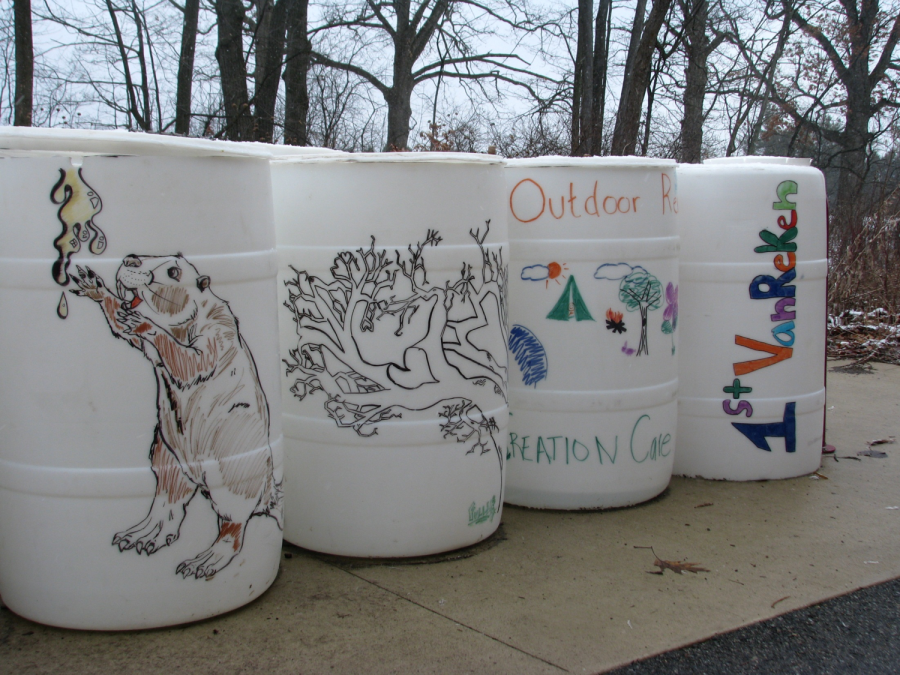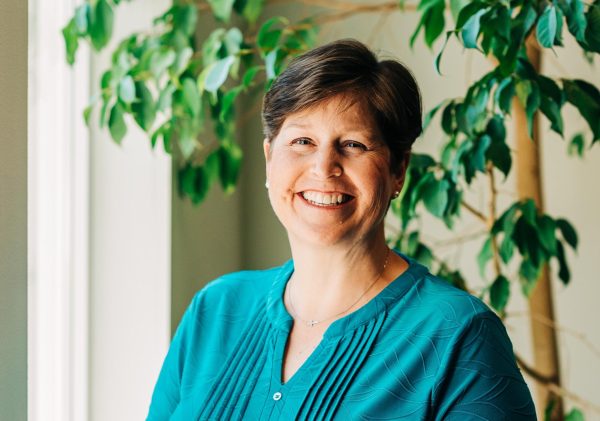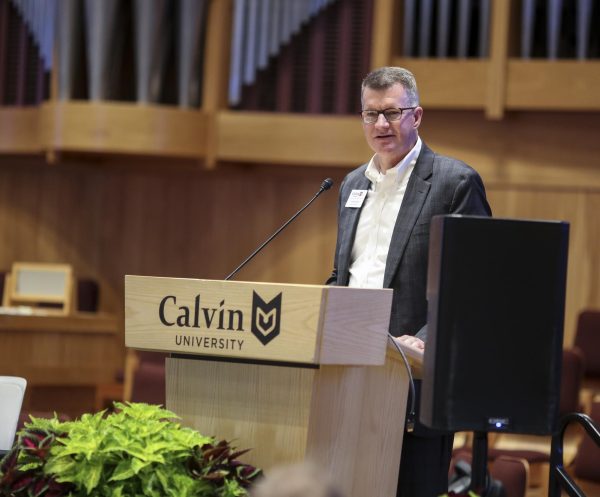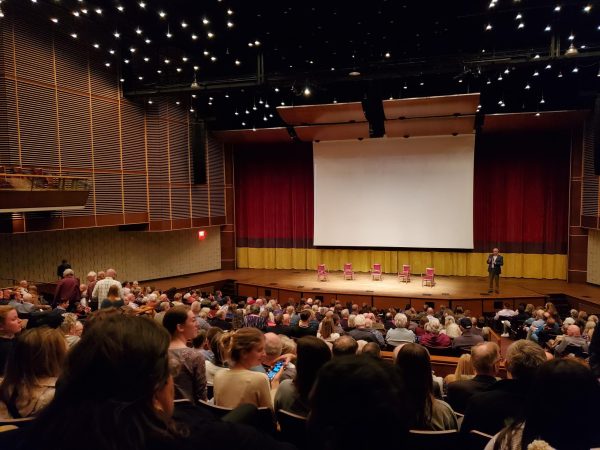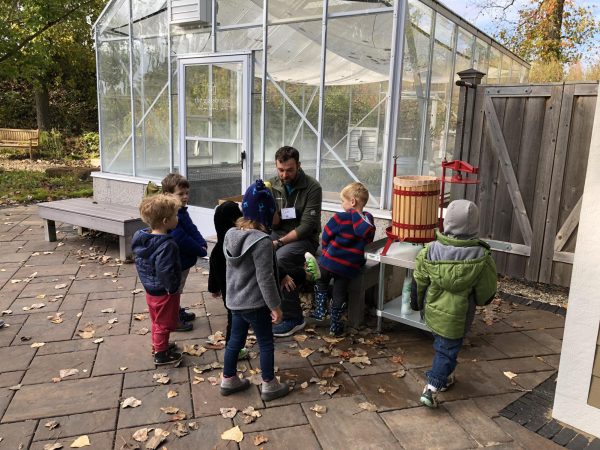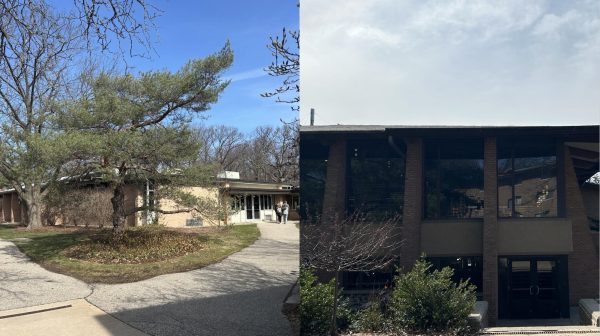Tapping potential: Maple syrup flows through campus
The sun shines off the reluctantly melting snow, and spring finally attempts to show itself. Students make their way along the cleared and salted paths, their salt-stained shoes testifying that they have walked them many times before. They walk beneath the branching shadows of trees, unaware of the process that is occuring within some of them.
As the weather continues to feel more like spring, students may begin to notice large white buckets appearing next to some of the trees they walk by every day. Clear tubes run from holes bored into the trunks, and a clear liquid oozes out from wood crevices into plastic barrels.
The slow flow of sap beats within the vein-like tracks of sugar maples. The sap rises with the temperature, beginning to dribble out from imperfections in the bark and run down the sides of the tree. One might spot a squirrel reaping the benefits of these scab-like openings. You might even see the clever animals making the small opening bigger to enjoy even more of the sticky goodness that the trees produce.
Humans on campus will take advantage of this phenomenon and bore their own holes in the trunks to coerce a slow current of the clear substance from the tree and into their buckets. This tradition began back in 2012 when, while observing a tree map created by geology professor Jason Van Horn, professor James Skillen noted the large number of sugar maples that Calvin hosts, and he saw an unrealized opportunity for the campus.
While Skillen was still in grad school at Cornell University, he worked in the department of natural resources and the Arnot forest, which is a teaching and research resource for the campus. Within the 1,500 acres of the forest, 100 acres consist of sugar bush. In the transition from winter to spring, Skillen would make his way down to the “sugar shack” and observe the copious amount of sap that would flow in from all the tapped sugar maples. Each tree would be tapped and connected to tubes that led to the sugar shack and the resulting sap would pour into the waiting vats.
Skillen brought his previous experience in the syrup process to Calvin where he discovered the literal untapped resources our trees had to offer. Though he came to Calvin in 2008, it wasn’t until years later that he became aware of the large number of sugar maples on campus after he happened to oversee Van Horn’s project with a biology class that was creating the Calvin Tree Map. For this project, biology students went out and identified every tree on campus to be mapped out. The information was then put onto a website. Students can go on the map and choose one species of tree to view and see how many and where that kind of tree can be found on campus.
“So one day I looked [at the map] and clicked sugar maple, and the possibilities there were fantastic! It seemed a shame that we had good sugar maples that weren’t being utilized,” said Skillen.
At that time, Skillen was a mentor for first van Reken, and was looking for interesting projects for the dorm floor to participate in. With some enthusiastic help from the physical plant, Skillen began this project in the winter of 2012.
“We didn’t have anything to get started. We bought things we couldn’t make, like taps, but then Phil Jaspers who runs the metal shop over in the engineering building, he and I welded this monstrosity we found: some scrap metal from campus. We welded a huge fire box and a stainless steel pan, and it was a pretty crude type of evaporator.”
With that in place they began to tap 40 trees, a number that has slowly gone up over the years. This year, an alumnus has donated a new evaporator. This one is also homemade, but since the alum owns their own metal fabrications company, it is a better “homemade,” according to Skillen.
The maple syrup process isn’t extremely complicated, just extensive. This year the process begins on Feb. 24, when about 12 students go to tap roughly 50 trees around campus. Each tree’s tap is led by tubing to a five-gallon bucket.
Students can then adopt a tree, and that is the tree they will go to between classes to check how much sap is being produced, and when the buckets are full they will be added to 55-gallon tubs. That happens during the week. The evaporator is run on Friday and Saturday. That’s a 24-hour process, and someone is needed to stand through the night to keep the mechanism running.
On Mondays, the syrup is bottled. Last year, about 100 twelve-ounce bottles were sold. Each year about 40 students are involved in the process from beginning to end. It used to be that only students from the first van Reken floor would be involved in the project. They used to be required to participate in the process. Skellen said the evaporator would be set up just west of the dorm, but that resulted in roomfuls of smoke for those who opened their windows.
First van Reken’s participation is now voluntary. Residents of the floor still get involved, but there are other students from the GEO department who also step in, and even invite friends to come along. As such, it has become a more campus-wide event.
“But van Reken is still kind of the sponsor of the whole thing,” explained Skillen.
Since the beginning of the project in 2012, it hasn’t changed much. There has been talk about going over to the substantial sugar bush that the nature preserve hosts, but the implications of walking 400 yards to get to the tapped trees is too time consuming for most students.
“The other interesting thing about syruping,” Skillen went on to say, “is that the amount of sap you get varies by tree, but it is also entirely weather-dependent. So when you have warm days above freezing, and cold nights well below freezing occurring multiple days in a row, it’s almost like a pump that pushes the sap up. So some years we’ll make a lot of syrup, some years less so and some years the sugar content changes.”
This kind of dependency can have major implications as to how much syrup the campus trees will be able to produce. Skillen recalled the highs and lows of Calvin’s syrup seasons:
“Our worst batch was, I think, 60 gallons of sap to one gallon of syrup. The best might be 28 gallons of sap to a gallon of syrup.”
Syruping is usually a quick process, but working around many college student schedules can complicate things. Beginning in mid-February, the cleanup is usually done around March 10, so as to be finished before all the students involved leave for spring break.
“So even though we might be able to get more sap out of the trees, I’m not quite up to the task of doing it all on my own,” admitted Skillen, laughing a bit.
This was started as a fun project, but Skillen notes how it can lead to a conversation on sustainability. In a small way, it is a form of sustainable agriculture right here on campus. You can tap a sugar maple for an extended length of time without doing any damage whatsoever. And the wood needed to use to run the evaporator is all cut from around the campus.
The syrup is sold by the GEO department, and the proceeds always go toward some campus project. This year they will be supporting the campus gardens.
Skillen also notes that the evaporator is a social event. While there are those who are set as overseers of the process, many will come just to hang out and see how syrup is made. Anyone can come just to observe and mingle. It will be running two Friday nights, March 2 and 9. The evaporator will be set up by the northeastern side of the Huizenga Track and Tennis Center. If you’re not sure where that is, but want to find it, Skillen says to “just follow the smoke!”



